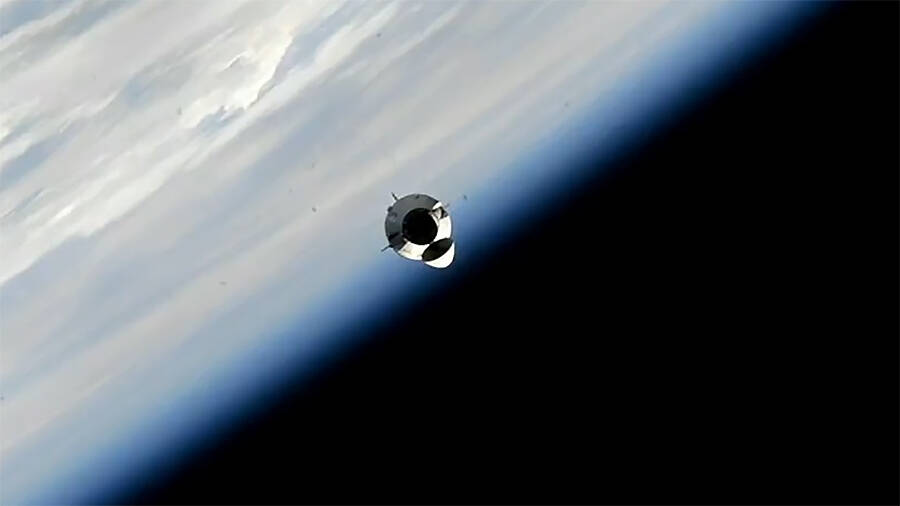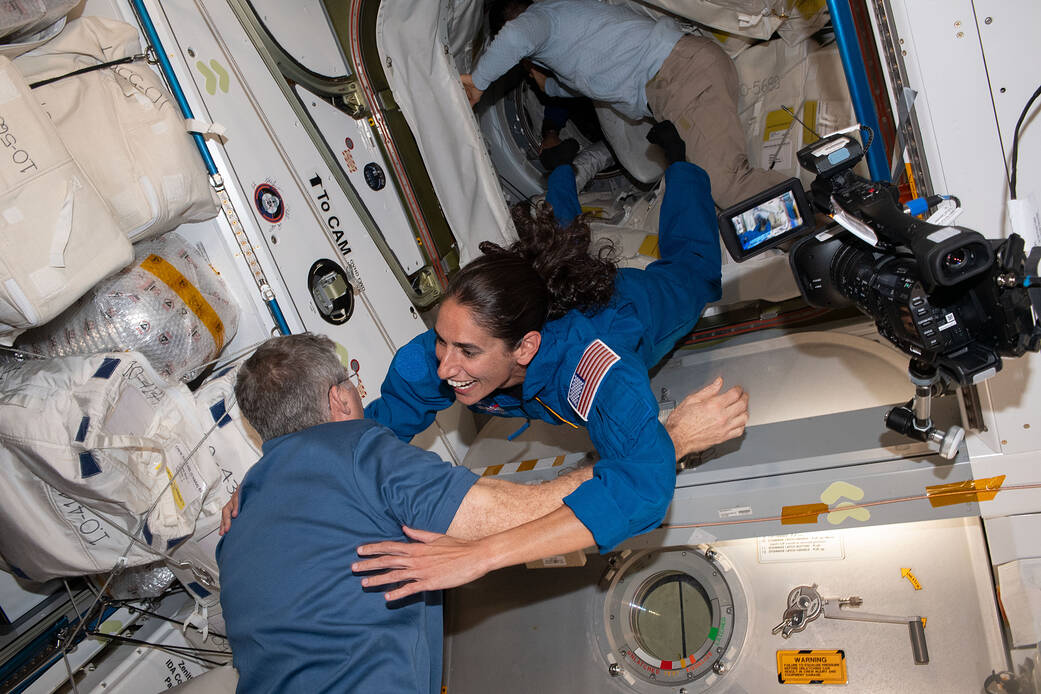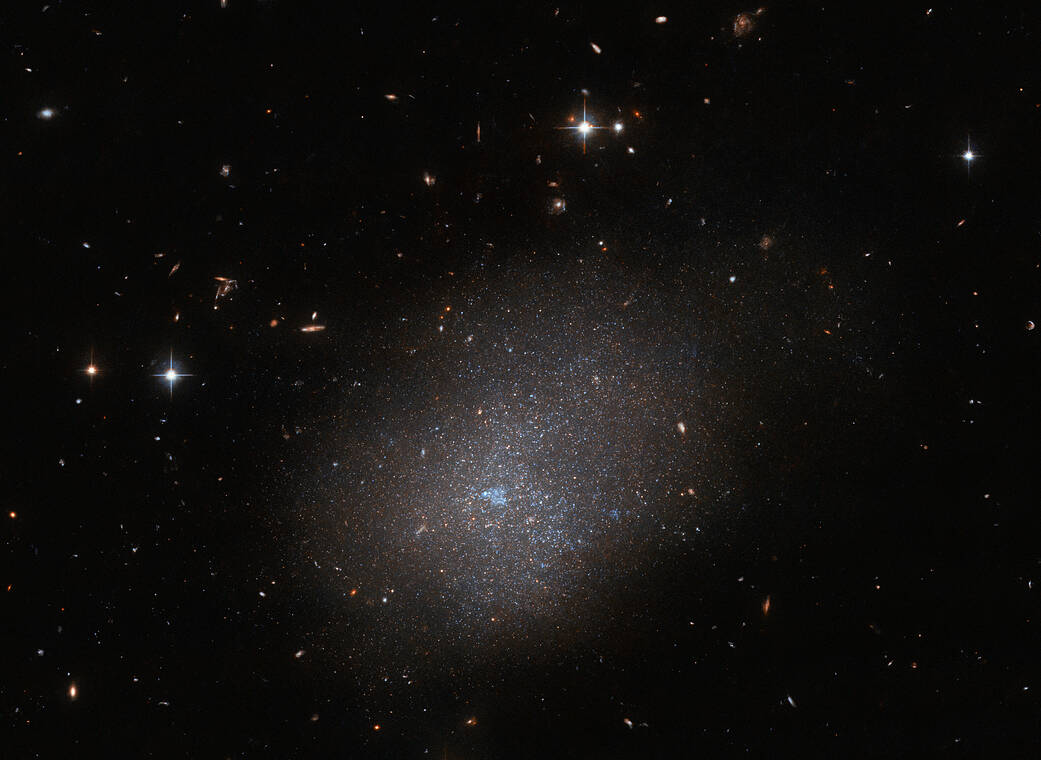In This Week’s Star
- Space Station Hosts 11 Crewmates from 5 Countries
- NASA’s Space-X Crew-6 Wraps Up Scientific Work
- Marshall Selects Kevin Flynn as Contracting Office Representative of the Year
- The SLS RS-25 Engine: 8 Minutes of Pure Power
- Chandra Study of Giant Black Hole Featured on ‘This Week at NASA’
- Hubble Sees a Sparkling Neighbor Galaxy
Space Station Hosts 11 Crewmates from 5 Countries
Eleven astronauts and cosmonauts are living together aboard the International Space Station following the arrival of the SpaceX Crew-7 mission on Aug. 27. While the new crewmates get adapted to life in microgravity, another crew is preparing for its departure this weekend.
The orbital outpost’s newest crew of four, representing the U.S., Denmark, Japan, and Russia, arrived aboard the SpaceX Dragon Endurance spacecraft. NASA astronaut Jasmin Moghbeli, ESA (European Space Agency) astronaut Andreas Mogensen, JAXA (Japan Aerospace Exploration Agency) astronaut Satoshi Furukawa, and Roscosmos cosmonaut Konstantin Borisov are familiarizing themselves with station safety procedures and getting used to life on orbit.
The Crew-7 crew are now Expedition 69 flight engineers and will live and work 260 miles above the Earth for the next six months. The new crew members were joined by station commander Sergey Prokopyev of Roscosmos and Flight Engineer Sultan Alneyadi of (UAE) United Arab Emirates) and reviewed the location of emergency hardware throughout the orbital lab.
Another crew is set to return to Earth this weekend after beginning its space station mission in March. NASA astronaut Stephen Bowen, commander of the SpaceX Dragon Endeavour spacecraft, will lead NASA pilot Woody Hoburg and mission specialists Alneyadi and Andrey Fedyaev of Roscosmos when they end their mission as Expedition 69 flight engineers. The quartet is scheduled to undock Endeavour no earlier than Sept. 2, and splash down off the coast of Florida. Watch live coverage of the SpaceX Dragon spacecraft hatch closing with Crew-6 aboard beginning at 6 a.m.
The Crew-7 mission launched at 2:27 a.m. CDT Aug. 26 from Launch Complex 39A at NASA’s Kennedy Space Center. The agency’s SpaceX Crew-7 mission is the seventh commercial crew rotation mission for NASA. A team of about 200 people at NASA’s Marshall Space Flight Center work in support of the Commercial Crew Program.
Watch a video with some of the commercial crew support team members at Marshall during NASA’s SpaceX Crew 7 launch. The team supported the mission long before lift-off by providing expertise in launch vehicle design and performance, and human space flight requirements. On launch day, Marshall team members monitored the vehicle, payload, and launch conditions.
NASA’s Space-X Crew-6 Wraps Up Scientific Work
NASA’s SpaceX Crew-6 soon wraps up its mission aboard the International Space Station. NASA astronauts Stephen Bowen and Woody Hoburg, UAE (United Arab Emirates) astronaut Sultan Alneyadi, and Roscosmos cosmonaut Andrey Fedyaev spent their months on the orbiting lab conducting scientific investigations and technology demonstrations that help prepare humans for future space missions and benefit people back on Earth.
Here’s a recap of the Crew-6 scientific journey aboard the space station.
The Payload Operations Integration Center, located at NASA’s Marshall Space Flight Center, consists of numerous team members who operate, plan, and coordinate the science experiments onboard the space station 365 days a year, 24 hours a day.
Learn more about the space station.
Marshall Selects Kevin Flynn as Contracting Office Representative of the Year

By Celine Smith
Kevin Flynn has always had an affinity for space.
Growing up in the San Francisco Bay Area, he enjoyed building model rockets. His interest in human flight continued to soar with his family attending air shows each year at NASA’s Ames Research Center in California’s Silicon Valley.
Today, Flynn works with NASA’s HLS (Human Landing System) program managed at NASA’s Marshall Space Flight Center. A key component of the Artemis missions, HLS will help to establish a long-term human presence on the Moon as the precursor for humans traveling to Mars.
“It’s a wonderful mission to be a part of,” Flynn said.
Marshall’s Office of Procurement recently selected Flynn as the center’s Procurement Contracting Office Representative of the Year for supporting the NextSTEP Broad Agency Announcement Appendix H Option A contract awarded to SpaceX for the development of their Starship Human Landing System.
HLS Program Manager Lisa Watson-Morgan appointed Flynn as the contracting officer representative in 2020. In that role, he is responsible for ensuring all the requirements of the contract are fulfilled by NASA and SpaceX
“As a COR for the HLS program, I am part of an excellent team and together we work hard to ensure the success of the Artemis missions,” he said.
Flynn’s 33-year journey with NASA was inspired when he was a junior in high school. A recruiter from Ames informed his chemistry class about summer internships at the center, which led Flynn to apply. His internship took place at an Ames biology laboratory and his time there led him to major in electrical engineering.
“I love using my hands and head to design and build things.”
He began working for Ames in 1990 after graduating from Santa Clara University with a bachelor’s degree in electrical engineering. In 1994, he earned a master’s from his alma mater.
Flynn worked as an engineering and project manager at Ames until 2003. He oversaw the development of aircraft avionics, shuttle payload electronics, aircraft payloads, instrumentation, and wind tunnel control electronics.
He then became the lead for the Ares I-X avionics and software project at Marshall. He also served as the deputy manager for Ares I-X vehicle integration and test at NASA’s Kennedy Space Center. He witnessed the successful flight of Ares I-X in 2009.
“Ares I-X exposed me to how the NASA centers work together to design and launch a test rocket. It was an excellent team to be a part of.”
Flynn joined Marshall as an engineering project manager for NASA’s Second Generation Reusable Launch Vehicle program. Prior to being appointed as contracting office representative on HLS, Flynn took part in the agency’s mid-level leadership program, graduating in 2017. Flynn managed several parts of the SLS (Space Launch System) core stage avionics, and then he managed the SLS Stages Business Office just prior to joining the HLS program.
NASA officially partnered with SpaceX to continue development of their Starship Human Landing System in 2021. Together, they are building an advanced lunar landing system by combining NASA’s vast experience with SpaceX’s technological capabilities.
Flynn hopes to be a project manager for future Artemis missions and continue mentoring others
“I’ve always loved the fact that NASA will encourage and support employee’s growth in whatever way they want to grow in the process of executing and contributing to NASA mission.”
Smith, a Media Fusion employee, supports Marshall’s Office of Strategic Analysis & Communications.
The SLS RS-25 Engine: 8 Minutes of Pure Power
When NASA’s SLS (Space Launch System) rocket roars to life on the launch pad, NASA’s Artemis astronauts inside the Orion spacecraft will feel the power of the rocket’s four RS-25 engines for eight minutes. Watch this video to learn more about how these engines have been adapted from the Space Shuttle Program for the SLS rocket’s bold missions into deep space.
The four RS-25 engines on SLS are the most efficient engines ever built. Two giant propellant tanks on the SLS core stage provide the fuel to power the engines that, together, provide more than 2 million pounds of thrust to help launch NASA’s Artemis missions to the Moon. The RS-25 engines are produced by Aerojet Rocketdyne, an L3Harris Technologies Company.
NASA’s Marshall Space Flight Center manages the SLS Program.
Chandra Study of Giant Black Hole Featured on ‘This Week at NASA’
Astronomers used NASA’s Chandra X-ray Observatory and ESA’s XMM-Newton to study material believed to be from a star that was ripped apart by a giant black hole – an event being called ASASSN-14li. The study is featured in “This Week @ NASA,” a weekly video program broadcast on NASA-TV and posted online.
The relative amount of nitrogen to carbon astronomers found indicates that the material weighs about three times the mass of our Sun – which would make the star in ASASSN-14li one of the most massive ever seen ripped apart by a black hole to date.
NASA’s Marshall Space Flight Center manages the Chandra program.
View this and previous episodes at “This Week @NASA” on NASA’s YouTube page.
Hubble Sees a Sparkling Neighbor Galaxy
The galaxy ESO 300-16 looms over a recent image from the NASA/ESA Hubble Space Telescope. This galaxy, which lies 28.7 million light-years from Earth in the constellation Eridanus, is a ghostly assemblage of stars which resembles a sparkling cloud. Other distant galaxies and foreground stars complete this astronomical portrait, which was captured by the Advanced Camera for Surveys.
This observation is one of a series which aims to get to know our galactic neighbors. Hubble has observed around three quarters of known galaxies within about 10 megaparsecs of Earth in enough detail to resolve their brightest stars and establish distances to these galaxies. A team of astronomers proposed using small gaps in Hubble’s observing schedule to acquaint ourselves with the remaining quarter of these nearby galaxies.
The megaparsec – meaning one million parsecs – is a unit used by astronomers to chart the mind-bogglingly large distances involved in astronomy. The motion of Earth around the Sun means that stars appear to slightly shift against very distant stars over the course of a year. This small shift is referred to as parallax and is measured in angular units: degrees, minutes, and seconds. One parsec is equivalent to the distance creating a parallax of one-arcsecond and is equivalent to 3.26 light-years or 19.2 trillion miles. The closest star to the Sun is Proxima Centauri, which lies 1.3 parsecs away.
NASA’s Marshall Space Flight Center was the lead field center for the design, development, and construction of the space telescope.






























